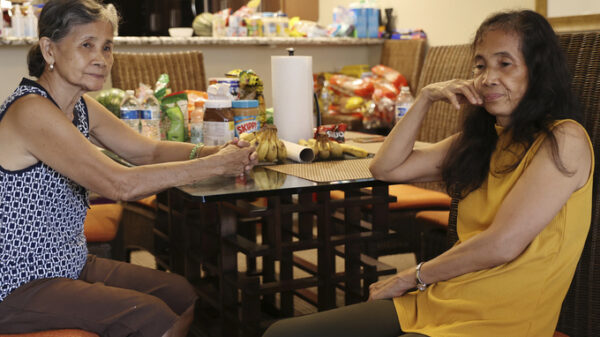Nelly Isaeva, director of Helping to Leave, stands for a photo in Kyiv, Ukraine, Tuesday, July 4, 2023. Isaeva works remotely to aid Ukrainians who are trapped on the east bank of the Dnieper River and want to escape Russian occupation. (AP Photo/Jae C. Hong)
KYIV, Ukraine (AP) — For Rima Yaremenko, the 5,000-kilometer (3,000-mile) odyssey to escape Russian occupation ended within sight of where it started. The 68-year old Ukrainian woman traversed several countries over six days only to settle across the river from her beleaguered hometown.
She came a long way by bus through Russia, Latvia, Lithuania and Poland to be this close. From the Ukrainian-controlled city of Kherson, where she now lives, the faint outline of Oleshky is visible from a distance. But the community with a prewar population of 25,000 may as well be a world away.
Yaremenko lived under Moscow’s rule for 15 months, putting up with the rumble of constant shelling just be near her beloved home and blooming garden. Then it was gone after the destruction of the Kakhovka Dam in early June triggered catastrophic flooding and reduced the property to clay.
She faced a tough choice: endure homelessness as the war raged nearby or take the only way out — a long, circuitous and uncertain journey through Russia. “We didn’t want to go, but once we were flooded, I decided there’s nothing to stay for,” she said.
Hundreds of others left, too, abandoning their water-logged homes to travel across vast sweeps of occupied land, past checkpoints that required nail-biting interrogations and through Russia’s urban heartland, all to reach the borders of the European Union.
Now that they are beyond the reach of Russian authorities, the escapees offered rare firsthand accounts to The Associated Press of their lives under occupation and their harrowing escape from Kremlin-controlled territory. Some of them spoke on the condition that they be identified only by their first names because they still have relatives living in occupied territory.
As the two sides blamed each other for destroying the dam, water levels declined and thunderous artillery fire resumed. Fighting intensified along the Dnieper River, which marks the line between Kyiv and Moscow’s battling armies. Russian allegations that Ukraine was responsible for the dam collapse were called into question by an AP investigation.
The constant shelling proved too much for those already struggling with homelessness and access to drinking water. Most did not have the money to rebuild. Occupation authorities offered a mere 10,000 rubles ($100) in compensation.
“My house was unlivable. Everything was covered in mud. The water pipes were broken and dirty. There was sewage,” said Lana, 43, who left Oleshky on June 19 and arrived in Kherson a little over a week later. “It was impossible to breathe. We were suffocating.”
Residents initially hoped a quick Ukrainian counteroffensive would free them. But the longer they remained, the more they feared pressure to acquire Russian passports.
“Although the water receded, the calamity persisted,” said Yevhen Ryschuk, Oleshky’s exiled mayor, who is in contact with residents.
The AP spoke to nine people who left Oleshky from June 13 to July 1. The only way out of the occupied part of the Kherson region was through Crimea, which Russia illegally annexed in 2014.
Travelers had to be processed in the administrative town of Armyansk, where phones are inspected, email passwords collected and those suspected of collaborating with Ukrainian forces interrogated or detained, in some cases never to be seen again.
Some are unable to pass simply because they lost their documents and have no money, said Nelly Isaeva, director of Helping to Leave, an organization that works remotely to aid Ukrainians who are trapped on the east bank and want to escape.
“Young people left, and pensioners stayed,” said Nataliia Skakun, 54, who recently left Oleshky with her husband, Serhii, and resettled in Mykolaiv, in the Kherson region.
A woman who remains in Oelshky said life under occupation has become harder over time.
The Russians “began to act more harshly than before,” she said, speaking on condition of anonymity out of fear for her safety. Russian soldiers now check the documents of locals, for example, when visiting the market.
For that reason, the woman and her family avoid leaving the house. Many people get by on the food that remains after others leave. “They give us their stocks,” she said.
Most townspeople who fled to Crimea continued their journey through the Russian province of Rostov-on-Don to Moscow and eventually made it to the Latvian border and then on to Lithuania. Many continued to Poland and crossed into Ukraine from there or stayed in refugee camps. AP also spoke to two people who traveled directly to Belgorod, which borders Ukraine’s Sumy region.
In Armyansk, a 50-year-old woman named Alla was questioned: Do you support Russia’s special military operation? Do you have contacts in the Ukrainian government? Who do you think exploded the dam?
She thought carefully about how to answer.
Alla had stayed because her 74-year-old arthritis-stricken mother didn’t want to go. Unable to bear it any longer, she took all the precautions she could by deleting potentially suspicious contacts and messages. She even told the Russian soldiers she was going to Simferopol, the capital of the Crimean Peninsula, and no farther.
The last 15 months were the hardest of her life.
“Every day in Oleshky was a risk. Every day I thought about leaving, but I couldn’t bring myself to make a decision. My mother is there, my house that we loved, that we dedicated most of our lives to build,” she said.
A few months into occupation, the ruble was enforced as currency. Alla had to exchange her Ukrainian hryvnias with a 10% fee. The last time she tried to purchase diabetes medication at the hospital she was told to present Russian documents the next time.
She lost friends: Some accepted offers to acquire Russian passports and housing certificates to purchase apartments inside Russia. Two of Yaremenko’s acquaintances did so too. “Our friends, for example, took the passports immediately. They say they feel it has become easier to live.”
The flooding was the last straw. Scores of homes were damaged. Many buildings still standing are uninhabitable. The treat of waterborne disease loomed.
At the checkpoint, Alla looked up at the Russian soldier. I don’t know who exploded the dam, she said, I just want peace. He let her through.
At the Latvian border, she was taken aside again and questioned in a room where a pair of handcuffs hung on a chair. Why leave? They asked. Why not wait for compensation? Why not look for a house in Russia?
Then they said they knew she had left her mother behind. If she dared return for her, they would not let her pass a second time, they warned.
“It was psychological pressure,” she said.
Those with a history of collaboration took greater measures to hide their past.
Yuri, 28, a former journalist, buried his press credentials and wiped his phone contacts. For months, he had been passing coordinates of Russian army movements to friends connected to Ukrainian forces.
In Oleshky, he had found work in a shawarma shop frequented by Russian soldiers, he said. “Every day you leave your house and don’t know if you’ll come back,” he said.
To survive, he was polite and struck up conversation with the soldiers. Some told him they would fight for the territory until the end. Others said they wanted to go home. He pretended to sympathize.
He was let through in Armyansk. Like so many others, he headed to the one place he felt most at home. Across the river, in the city of Kherson, where Russian bombardment is constant.
“It’s absurd in a way,” he said with a laugh. Only a few weeks ago, he could see the Ukrainian-controlled city from his building under occupation. “It was just 20 minutes between Oleshky and Kherson. Now it’s three days.”
Copyright 2021 Associated Press. All rights reserved.










































